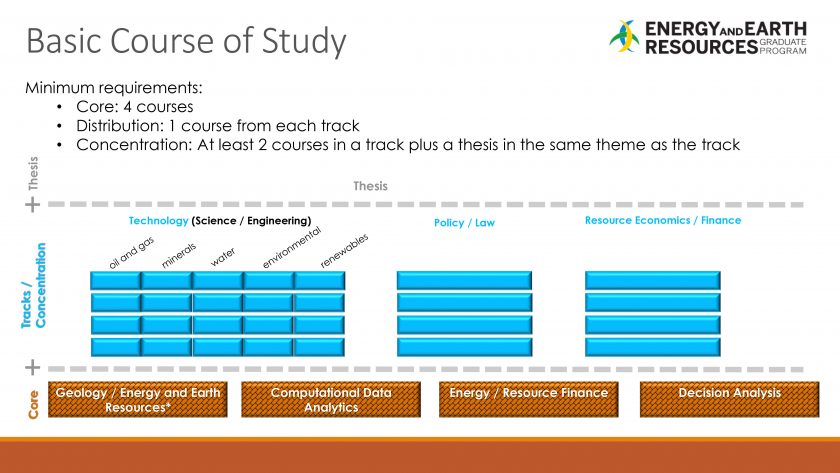The EER Course of Study
Course Requirements
The EER program has offered the Master of Science in Energy and Earth Resources since December 2013 to eligible candidates.
The Master of Arts in Energy and Earth Resources (EER) and the Master of Science in Energy and Earth Resources (EER) requires 30 hours of graduate course credit of which 6 hours are thesis. Three hours of upper division undergraduate course work may be counted toward the 24 hour course requirement with the approval of the Graduate Advisor.
Core Courses
Students entering the program without a geology course that includes the origin and distribution of energy, mineral, and water resources will be required to take a geology course, GEO 386R/EER 396 Geology of Earth Resources. This course should be taken during the first semester of the program. Please note that if your undergraduate degree is focused on any of the core course subjects, you are required to take a higher level course in that core subject. For example, if your undergraduate degree is in Operations Research, you would have to take an Operations Research course that is above the level of Decision Engineering.
Effective for the incoming class in the fall of 2018, four core courses will be required of every EER graduate. These build generic foundation knowledge and skills. Our belief is that every EER student, regardless of concentration, needs to be able to:
- understand Earth and its controls on resource distribution
- gather and analyze large data sets and derive useful information
- make energy / earth resource decisions in the context of commercial viability
- make energy / earth resource decisions in the context of risk and uncertainty
The courses that address these requirements are:
- Geology of Earth Resources (GEO 386R/EER 396), Dr. Richard Kyle and Dr. Dana Thomas
- Python for Geosciences Research (GEO 391), Dr. Gail Christeson
- Energy Finance (EER 396), Dr. John C. Butler and Dr. Joe Hahn
- Decision Engineering (ORI 390R), Dr. Eric Bickel
Concentrations
- Resource Economics/Finance
- Policy/Law
- Technology (Resource Science and Engineering)
Students will be required to take at least one course in each track and at least two (preferably three) courses in a single track to develop a concentration. The thesis (see below) is designed to supplement the coursework in the concentration.
Thesis
Each EER student is required to take Thesis A and Thesis B to provide 6 credit hours of thesis. Thesis A must be taken before Thesis B and is normally taken in the third full semester in the EER program.
Before approval is given by the Graduate Advisor to take Thesis A, the student must have identified his/her thesis supervisor and readers and have reported this to the Graduate Advisor and the Graduate Coordinator at a specified date before the end of the second semester of the program. Potential thesis supervisors include members of the EER Graduate Studies Committee. Other appropriate members of the university research community may serve as readers or co-supervisors of EER thesis research with an EER GSC member. An outside (non-UT) reader is feasible, but must be approved by the program and meet guidelines. All students are required to make a public presentation of their thesis research prior to their graduation.
Thesis Sequence
Second Semester
Prepare research / thesis proposal and identify supervisor and two (2) readers for a total committee of three (3) members before the end of the first week of April of the second semester. Must be approved by Graduate Adviser.
Third Semester
Thesis A: Gather and analyze data; prepare a supervisor-vetted progress report and submit to the EER graduate office.
Fourth Semester
Thesis B: Synthesize results, draw conclusions and write the thesis. Submit draft for supervisor review by mid-March to allow for one or more revisions. Following supervisor approval, submit thesis to other committee members, allowing time for additional revisions. Make public presentation of your research results.
Summary of the Course of Study (effective fall, 2018)
The following graphic (click to enlarge) describes the EER course of study, effective for the incoming class in the fall of 2018:

